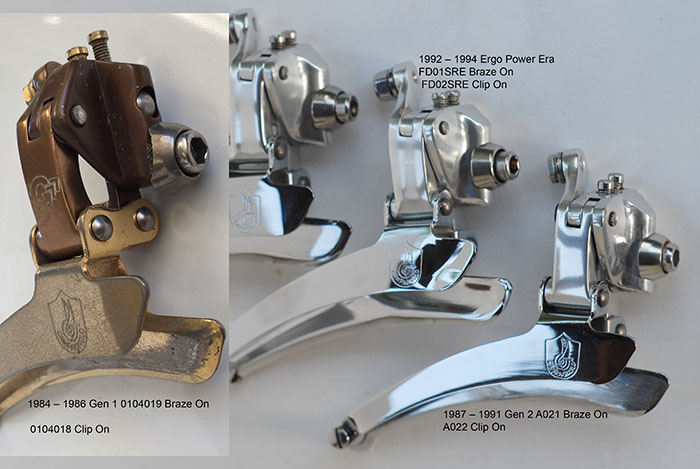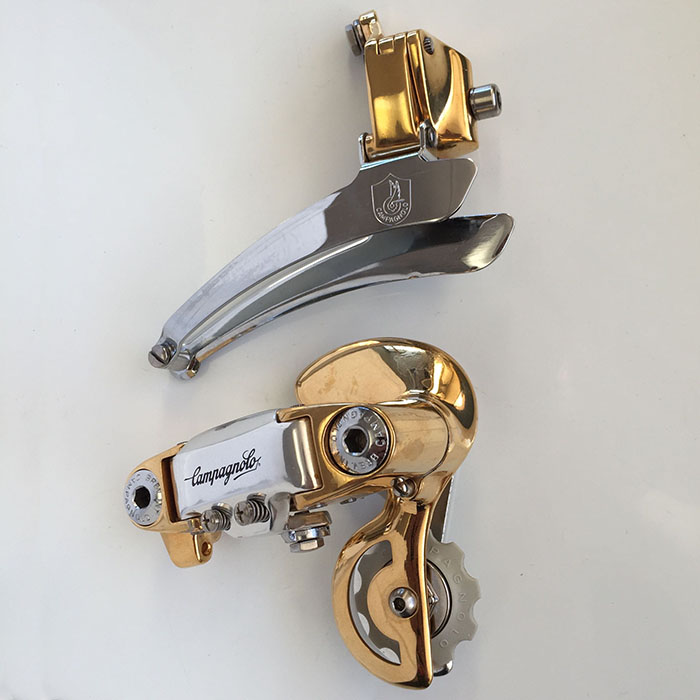The holy grail of derailleurs for some, is the Gen 1 Campagnolo C Record rear derailleur, rare and expensive if you can find one, especially in NOS condition. Yet search Ebay or related sites looking for the matching Gen 1 Campagnolo C Record front derailleur for sale, you'll be lucky to find one in any condition. Lasting a maximum of two years in production and quickly superseded, you'd be excused for not knowing that the braze on C-Record Gen 1 front derailleur version even existed. If you do find a Gen 1 Campagnolo C Record front derailleur, it will most likely be the clip on version, still in production and unchanged until about the end of 1988. It seems Campagnolo was slow to upgrade the clip on version, while the new Gen 2 braze on Campagnolo C-Record front derailleur was available by 1987.
Between 1984 and 1994 there were three Campagnolo C Record front derailleur versions. New serial numbers were issued with the announcement of each version. At a glance it would be difficult to pick the three apart, the design remained consistent for a decade.
Identifying the Campagnolo C Record front derailleur by year and serial number.
1984 - 1986 Gen 1 0104019 Braze On / 0104018 Clip On
1987 - 1991 Gen 2 A021 Braze On / A022 Clip On
1992 Gen 3 FD-01FRE Braze On / FD-01SRE Clip On
1993 - 1994 Updated Version FD11SRE Braze On / FD11FRE Clip On
1995 - Introduction of a new Record group, this front derailleur was the first readily identifiable departure from C-Record with a major re-design in styling.
Identifying the Campagnolo C Record front derailleur.
Throughout 1985 and 1986 Campagnolo Catalogue n 18 identified the components from end of the Tulio Campagnolo era, including Super Record and Record. The design of completely new groupsets for the C-Record era introduced new "aero" styling, branding and naming of groupsets, including a new logo. This was problematic because the new top of the range groupset was simply meant to be called "Record" yet the previous second level group was also called "Record" and still identified as being in production and published in Catalogue n 18 right up to the end of 1986. The idea was to ditch the old group names Super Record, Record, Gran Sport, Touring, 980 Equipaggiamento, Nuovo Record, Nuovo Gran Sport and Valentino Extra. Replacing these group names completely with, Record, Victory and Triomphe. Chorus and others would come later.
In their commitment to change at Campagnolo, mid 80's management acknowledged Tulio's historical influence while pressing the point that their managerial team is still "valid" without their patriarch. Campagnolo mangement distancing themselves from the past with, "Those times are now far away." There were a lot of changes to make and it was as if n18 bis was published as a stop gap while the new "Record" range was under development. Not to mention the impending onslaught of the Japanese manufacturer Shimano who could also manufacture entire groupsets. Shimano were about to make big changes and Campagnolo never saw it coming. The failure of the very first production run of 1 Gen Delta brakes a notable standout. The 1 Gen C-Record front derailleur appears to have been on the same list of innovations that required improving.
In April 1985 Campagnolo Catalogue n 18 bis introduced the new groupsets for the Campagnolo C-Record era. In this catalogue Campagnolo referred to the new top of the line groupset, variously as Record, C-Record and C-Record corsa. With the old Record group still available, it's no wonder the new flagship groupset became known as C-Record for the sake of simplicity.
Below is the exploded diagram included in the Campagnolo catalogue n18 bis, showing the component parts of the C-Record 1st Gen front derailleur. (1984-1986 Gen 1 0104019 Braze On / 0104018 Clip On) The differences to the gen 2 version are :
1. Has an arm stop plate which was absent on the gen 2 version.
2. The cage / fork is pinned horizontally to the derailleur arms. On the Gen 2 braze on version this is achieved with diagonally opposed pins.
3. The cage fixing pin for the inner arm is exposed on the front of the derailleur. On the Gen 2 version the extra inner arm pin is excluded and combined into one with the fixing screw.
4. Many but not all of the Gen 1 C-Record front derailleurs did not have "Made In Italy" stamped into the back of the cage / fork.
The new design of the Gen 2 Campagnolo C Record front derailleur for 1987 was outlined in the USA edition of the Campagnolo brochure.
An important detail is the cable fixing system. A molded clamp washer compresses the cable against the connecting rod arm by means of a fixing screw, the clamp washer has a tooth inserted into the arm hole, preventing the clamp washer from rotating and the cable from spilling. Consequently, wearing and slipping of the cable is prevented.
Further improvements to the derailleur include the repositioning of the derailleurs limit stop screws making them more convenient to adjust along with the addition of coaxial springs to ensure the adjustment will not be affected by vibrations.
To complete the changes to the derailleur, Campagnolo has re-profiled the parallelogram for a smoother look.
Greg Softley, curator and owner of one of the world's most inclusive collections of rare bicycles, has an eye for extremely rare parts. Greg showed me a gold plated Campagnolo C-Record front derailleur, a braze on version with the letter G engraved into the front arm above the Campagnolo shield logo. Reputedly the G stands for "Gerber" a Swiss firm, yet I've not been able to confirm this detail. The important distinction is that we have a very early, gold plated Campagnolo C-Record braze on front derailleur, it's a unique and highly collectable item if you are into that sort of thing, probably dating from 1984 or 1985. Apart from the faded gold plating, other plated finishes and the Gerber logo, this derailleur is a perfect match for the Gen 1 0104019Braze On version listed in catalogue n18 bis, and perhaps even an early working prototype.
Thanks to Greg Softley for supplying all the gold Campagnolo derailleurs for photographs. All images by Robert Cobcroft.





























Shimano vs Campagnolo in the 80's & the beginning of Carrera Bicycles